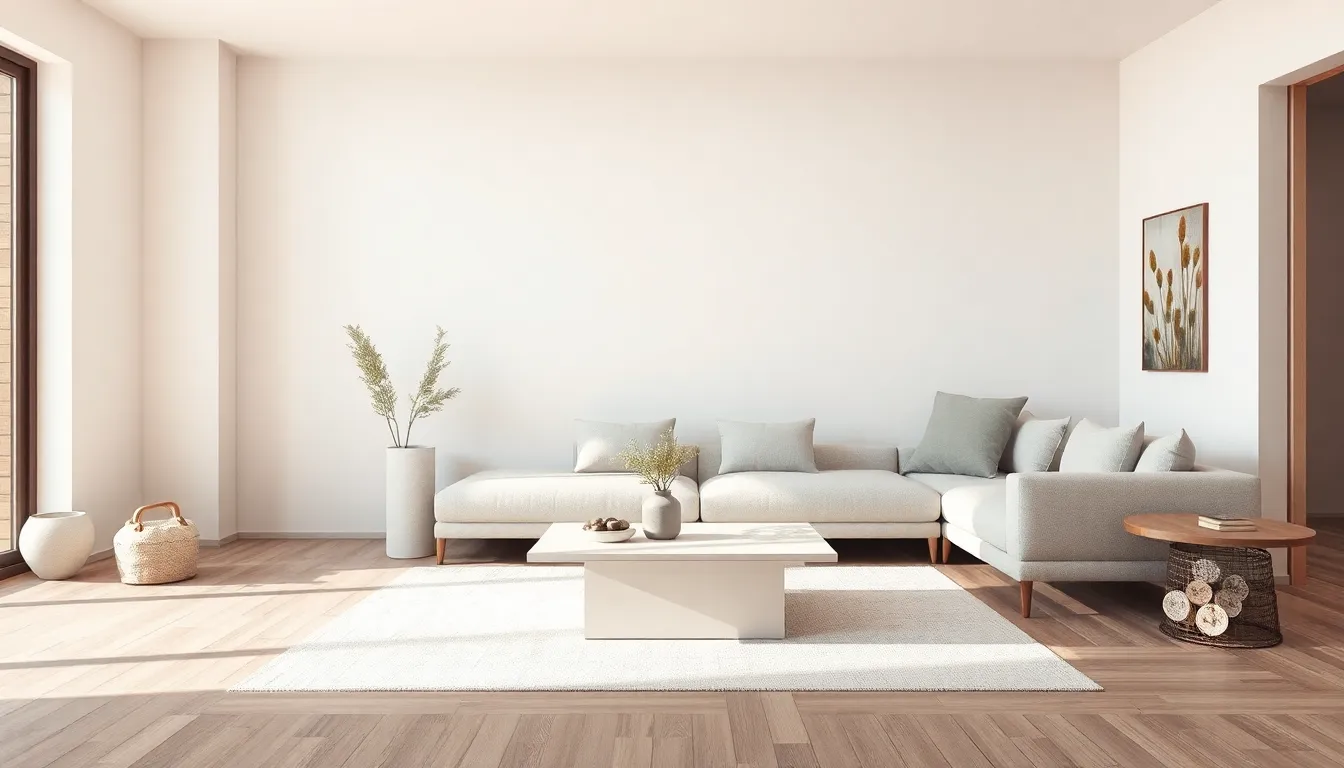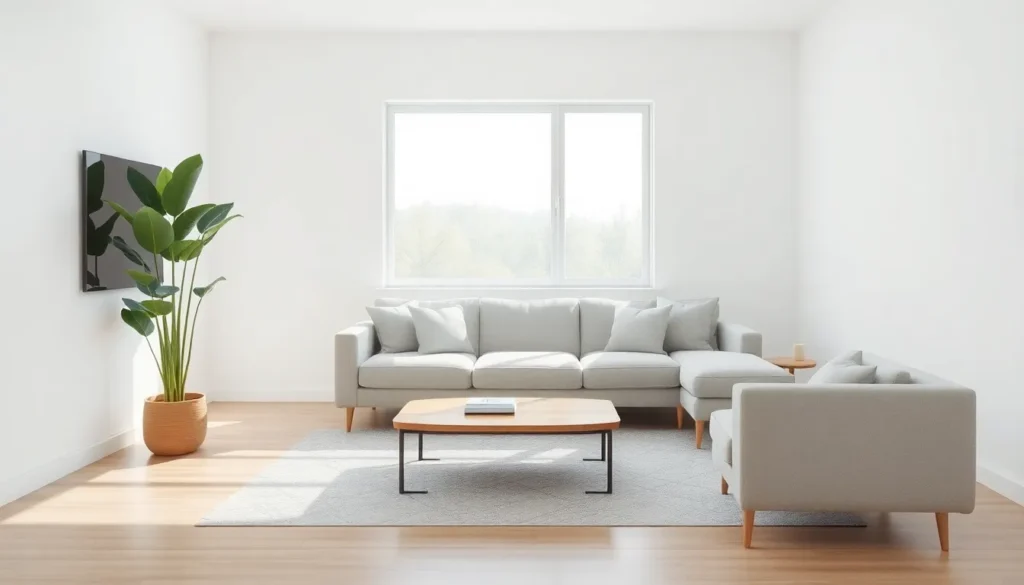In a world where clutter seems to multiply faster than rabbits, embracing minimalism in the living room can feel like a breath of fresh air—or a much-needed vacation from chaos. Picture this: a serene space where every item has a purpose and a place, and you can finally find that remote control without a scavenger hunt. It’s time to transform your living room into a haven of calm and clarity.
Table of Contents
ToggleUnderstanding Minimalism in Living Rooms
Minimalism emphasizes simplicity and functionality in living rooms. This approach promotes a space that feels open and calm while maintaining aesthetic appeal.
The Principles of Minimalism
Focusing on essential elements defines minimalism. Objects in the living room should serve a clear purpose, enhancing the space’s functionality. Additionally, using a neutral color palette creates a serene atmosphere, allowing natural light to play a significant role. Prioritizing quality over quantity leads to lasting design choices. Emphasizing clean lines and uncluttered surfaces further contributes to the minimalist aesthetic.
Benefits of a Minimalist Living Room
A minimalist living room reduces stress and distractions. Less clutter creates a sense of calm, making it easy to relax after a long day. Simplified spaces also promote organization, allowing easier access to important items. Implementing minimalist design encourages mindful consumption, leading to more sustainable living choices. Ultimately, a minimalist living room fosters a harmonious environment that brings peace and tranquility into daily life.
Essential Elements of Minimalist Design

Minimalist design relies on key elements that create a serene and functional living room. By emphasizing simplicity, homeowners achieve an inviting space that reduces distractions.
Color Palette and Materials
Neutral color palettes dominate minimalist designs. Soft whites, warm grays, and muted earth tones work together to foster a calm atmosphere. Natural materials like wood, stone, and metal promote a sense of tranquility. Select furniture crafted from quality materials to ensure longevity. Minimalist spaces benefit from texture variety, creating visual interest without clutter. Incorporate soft fabrics like linen or wool to enhance comfort while keeping the aesthetic clean.
Furniture Selection and Arrangement
Selecting furniture requires careful consideration of functionality and form. Compact and multifunctional pieces take precedence in minimalist environments. Consider items like a sleek coffee table with storage or a sofa that accommodates more guests. Arranging furniture thoughtfully enhances flow and movement within the space. Maintain open pathways to encourage interaction and ease of access. Keeping surfaces uncluttered promotes organization, allowing each piece to shine without overwhelming the eye.
Creative Living Room Minimalist Ideas
Incorporating creative minimalist ideas into a living room enhances its functionality and aesthetics. These strategies promote an organized and serene environment.
Multi-Functional Furniture
Choose multi-functional furniture to maximize space and efficiency. Convertible sofas provide seating while transforming into beds for guests. Nesting tables offer the flexibility of extra surfaces when needed but can be compactly stored when not in use. Ottomans with hidden storage can double as seating and provide a place to stow away blankets or magazines. Select furniture pieces that harmonize style and practicality while ensuring easy movement throughout the room.
Decluttering and Organization Tips
Implement effective decluttering and organization techniques for a minimalist living room. Begin by assessing items, keeping only those that serve a purpose or hold significant value. Use storage solutions like baskets or decorative boxes to hide items from view. Consider vertical space; floating shelves display essential decor while maintaining open floor space. Regularly evaluate belongings to prevent clutter from accumulating, thereby fostering a tranquil atmosphere. This approach creates a clear and soothing environment that encourages mindfulness and functionality.
Incorporating Natural Elements
Incorporating natural elements enhances the minimalist aesthetic while promoting tranquility in the living room. Focus on integrating aspects of nature for a harmonious atmosphere.
Adding Plants and Greenery
Adding plants introduces a vibrant touch to the space. Plants like snake plants, pothos, and peace lilies add color and improve air quality. Small potted plants can serve as centerpieces on tables, while larger floor plants create significant visual interest without cluttering. Succulents require minimal care, making them ideal for busy lifestyles. Window sills and shelves are perfect spots for greenery, enhancing the minimalist approach with natural life.
Maximizing Natural Light
Maximizing natural light elevates the minimalist feel of the living room. Large windows and mirrors help reflect light, creating an open and airy environment. Utilize sheer curtains to allow sunlight to filter in gently while maintaining privacy. Light fixtures should complement the natural light, using designs that embody simplicity. Orient furniture in ways that promote light flow throughout the room, fostering a warm and inviting ambiance. Emphasis on natural illumination enhances both aesthetics and functionality, supporting the minimalist philosophy.
Embracing minimalism in the living room transforms it into a serene sanctuary. By prioritizing essential elements and maintaining a neutral color palette, individuals can create a space that feels open and inviting. The thoughtful selection of multifunctional furniture and natural elements not only enhances functionality but also promotes tranquility.
Regularly assessing belongings and utilizing smart storage solutions ensures a clutter-free environment. This mindful approach fosters a harmonious atmosphere that encourages relaxation and focus. Ultimately, minimalist living is about finding peace amidst simplicity, allowing every item to contribute meaningfully to the overall aesthetic and functionality of the space.





